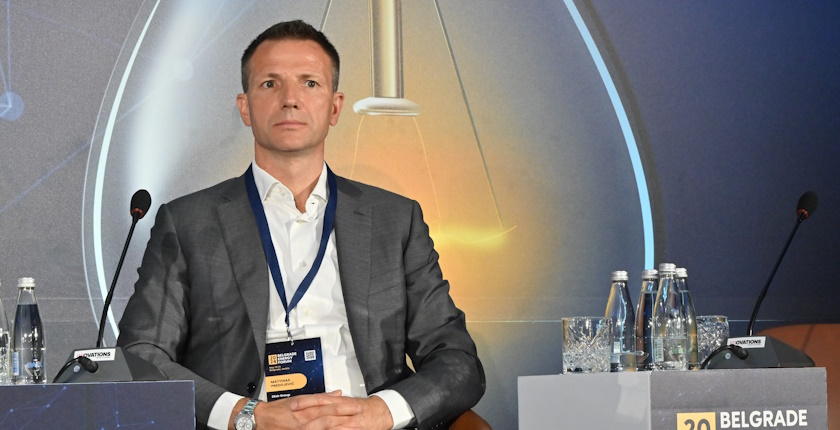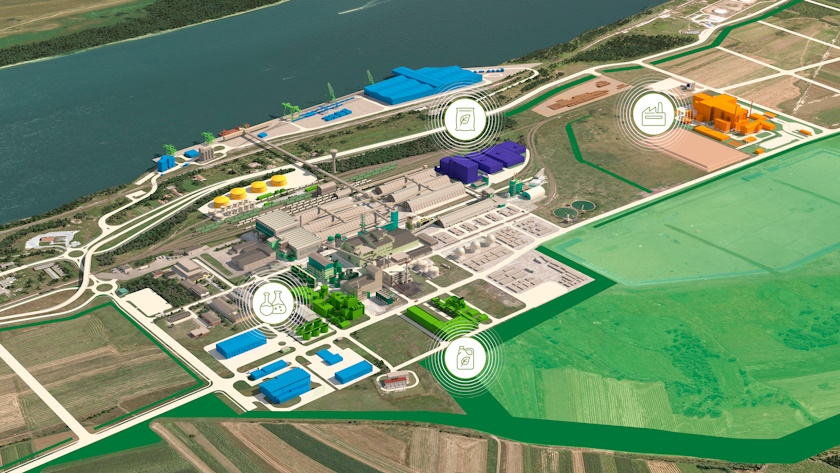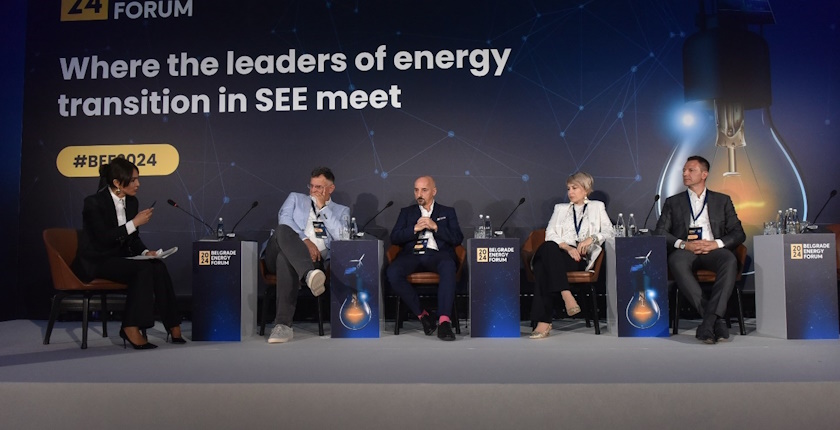
Photo: Balkan Green Energy News
Elixir Group, the leading manufacturer of phosphoric acid and mineral fertilizers in the region, has raised its own ladder of goals for contributing to global efforts to reduce GHG emissions with its Prahovo 2027 investment cycle. The implementation of ambitious plans to reduce carbon dioxide emissions in production processes and achieve cleaner production, presented at BEF 2024, are also a key part of this company’s preparations for the implementation of the Carbon Cross-Border Adjustment Mechanism (CBAM), which energy-intensive industries expect from January 1, 2026.
“In Europe, energy represents about 70 percent of all GHG emissions, and it is similar here at Elixir. Our technological processes are not carbon-laden and the dominant share in the carbon footprint of our products comes from the use of fossil fuels. That is why an important part of the large Prahovo 2027 investment cycle that we will implement in the next three years is represented by projects that will reduce energy consumption per ton of products, and projects that will decarbonize the sources of energy necessary for our production”, says Matthias Predojević, Elixir Group VP for Corporate Development, in an interview with Balkan Green Energy News.
At the production location in Prahovo, which is the center of Elixir’s chemical production, four new greenfield plants with a completely new industrial infrastructure will be built by 2027, which are investments worth around 300 million euros. “These investments will create 200 to 300 new jobs, all with the goal of becoming the most modern industrial-chemical park in this part of Europe,” says Predojević.
As he explains, the investment cycle is designed to primarily harmonize the production in Elixir Group with the requirements of the European Green Deal and the Green Agenda for the Western Balkans, with the aim of achieving climate neutrality by 2030 and securing a leadership position in the European market.
“The CBAM requirements, are aimed at reducing CO2 emissions and encouraging cleaner industrial production, are directly integrated into our strategy. The new phosphoric acid factory will use advanced technology to reduce the energy consumption per ton of phosphoric acid produced by 50 percent, which will directly affect the reduction of the carbon footprint of all our products. Water consumption will be also significantly reduced and the degree of circularity of all materials at the location in Prahovo will be increased; this will further confirm our commitment to the rational use of natural resources”, explains Predojević.
What is the importance of the waste-to-energy plant for the decarbonization process in Elixir?
The construction of a waste-to-energy plant that will use waste for energy is a central part of Elixir Group’s strategy of decarbonization of energy needs in Prahovo.
This innovative plant will use non-recyclable industrial waste as fuel and thus significantly reduce the dependence of our production processes on the use of fossil fuels such as coal, fuel oil and gas.
Energy utilization of waste reduces the carbon footprint per ton of phosphoric acid produced. This directly and indirectly decarbonizes all our products
By energy valorization of waste and thus obtained heat necessary for our production processes, we will additionally reduce the carbon footprint per ton of phosphoric acid produced. This is how we decarbonize all our products, both directly and indirectly, because phosphoric acid is the basic raw material in all our production processes.
Even indirectly, our new and innovative products of liquid, powder and crystaline fertilizers will contribute to sustainable agriculture, which is resource efficient, and which reduces CO2 emissions to a minimum. Through these measures, the Elixir Group actively implements the decarbonization of production processes and alignment with the requirements of the European market, thus remaining competitive leaders in that market.

What is the impact of such facilities on the development of circular economy?
Waste-to-energy plants represent the only alternative for permanent disposal of non-recyclable waste into the environment, which according to the hierarchy of waste management prescribed by the European Union -which is also applied through our legislation – is the least desirable option.
Waste-to-energy plants play a key role in the circular economy and are complementary to the recycling industry
In other words, waste-to-energy plants play a key role in circular economy and are complementary to the recycling industry. By using waste to obtain energy, they reduce significantly the volume of non-recyclable waste that is disposed of in the environment and in this way, bring benefits to the entire social community.
Can the process of reducing emissions during the entire life cycle of the product remain only within the perimeter of factories, or should the wider community be involved?
Although factories play a key role in managing Scope 1 and 2 emissions, the bigger picture is much more complex. Involvement of the wider community, changing the habits and awareness of citizens is necessary. We are all part of that chain – from suppliers and carriers to end consumers. For example, how consumers use the products, and how efficient recycling streams are, can significantly affect the ultimate environmental footprint. Therefore, it is a matter of joint effort and continuous education, to minimize the negative impacts on our planet together.
What are your company’s plans regarding greater use of renewable energy sources, investment in own power plants, or PPA contracts?
Elixir Group’s strategic goal is the decarbonization of our entire business, including the fertilizer business, the production of phosphoric acid, and our other products. We have identified energy consumption as a key area for the decarbonization of our business operations, and our efforts are going in two directions. First, we want to increase energy efficiency, that is, to reduce the consumption of heat and electricity per unit of product, which we will achieve by building a new phosphoric acid factory, using new, more resource-efficient technology, while we intend to meet the remaining energy needs from alternative and renewable energy sources.
In terms of electricity, we are currently searching for the optimal capacity, the technology, and the way of balancing energy from solar panels and wind farms
In terms of heat, the waste-to-energy plant will replace the fossil fuels we currently use to produce steam, while in terms of electricity, we are currently looking for the optimal capacity, the technology, and the way to balance energy from solar panels and wind farms. We are aware of the advantage of PPAs, primarily in terms of relieving the future consumer of “investor worries”, but we have not yet made the final decision and are still looking at the best options.
What do you see as the biggest challenge for achieving full decarbonization of the company by 2030?
We see the biggest challenge for achieving full decarbonization of the company by 2030 primarily in technical solutions and their efficiency. As you have seen, the investment cycle of Prahovo 2027 and over 300 million euros of investments, unequivocally speaks of our will to ensure the successful implementation of our decarbonization strategy.
It is certain that our preferred suppliers will need to be as committed to the Green Agenda as we are
What is not “in our backyard”, i.e. what does not depend on the company whose carbon footprint is being observed, is Scope 3, i.e. emissions incorporated into raw materials, as well as the transportation of raw materials to factories, i.e. distribution of products to customers.
It is certain that our preferred suppliers will need to be as committed to the Green Agenda as we are, but it is up to them to show initiative and implement solutions to decarbonize their own production. Also, regarding the transportation of goods, we expect significant changes in the global mobility industry, and we will wholeheartedly accept them at the moment when the solutions are proven in practice and are available in our region.
I emphasize once again, our goal is ambitious, and we believe that with careful planning and implementation of concrete steps, as well as cooperation with suppliers and the transportation industry, we will succeed in achieving full decarbonization of our business operations by 2030.
What does CBAM reporting look like in relation to CO2 emissions to EU partners and domestic institutions at the moment?
Currently, the CBAM transition period is in effect, which started on October 1, 2023, after a two-year preparatory period. The transition period is implemented by quarterly submission of information on the carbon footprint per ton of products placed on the EU market during the observed quarter, and then EU buyers – importers, in the role of official declarant, pursuant to CBAM regulations, formally fill in the CBAM declaration based on the submitted data. The goal of this three-year transition period is to collect data, test the reporting system, and adjust procedures to ensure full compliance with the regulation. After this transition period, carbon pricing of non-EU products will begin, identical to the taxation system that applies to EU producers.

What is your experience with the transition period specifically?
Elixir Group has no major difficulties in the transition period solely due to the great precaution we took and thorough preparations we have carried out in order to adequately respond to the requirements of the regulation.
At the end of January, we have submitted the first CBAM report related to the fourth quarter of 2023
We have made significant efforts to first understand the regulation in detail and correctly, and then to properly calculate the carbon footprint and deliver the data to customers in an understandable format and in a timely manner. At the end of January, we have submitted the first CBAM report covering the fourth quarter of 2023, while the second report was submitted in April, covering fertilizer exports to the EU during the first quarter of 2024.
Does Serbia have enough people trained for these jobs and what kind of support can be provided to companies entering this process?
The CBAM regulation is new and complex and, as such, requires significant time to understand and adapt to, and it is a major challenge for all participants in the process. Elixir started to build internal capabilities on time and to develop in house expertise from the very preparation period of the regulation, while in parallel we consulted with specialized foreign experts, as well as with rare domestic experts who understand this field.
The Elixir team, with the support of UNDP, created a document – Decarbonization Roadmap, which is publicly available
It goes without saying that the actuality of the regulation and its complexity represent a special challenge for all of us, and with this scope coverage it mainly targets large companies from the steel, aluminum, cement, mineral fertilizers, and energy industries. The organization of various educational workshops and seminars that were and are being conducted by the Serbian Chamber of Commerce is a good approach, and, with the support of UNDP, the Elixir team developed a document – Decarbonization Roadmap, which is publicly available for everyone interested in this topic. Additional manuals and practical tools for the implementation of new regulations can significantly reduce the pressure in adapting to new requirements.


















What about decarbonization of metal like Silver !?
For 1t of Ag we get more 900.000t of CO2 !?
Stop making then Silver !